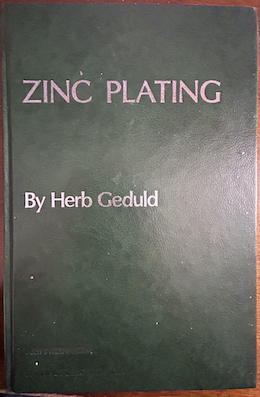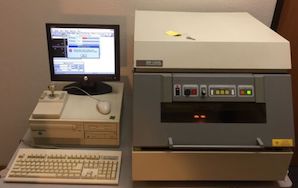
-----
Spot test to Verify Zinc Plating. ASTM A239 / Preece Test / Copper sulphate
Q. What is a PREECE TEST?
Joe B. Rivas- Long Beach, California
2001
A. Check the Advanced Knowledge Technologies department at the University of Aberdeen (Scotland). Professor Alun Preece is one of those involved with that project. This is the only reference that appears close, but you did not indicate the type of process or material you were needing to test - sorry.
W. Carl Erickson- Rome, New York, USA
2001
A. Preece test is the following ASTM test:
A191- Discontinued 1942: Test Method for Uniformity of CoatIng by the Preece Test (copper sulphate
⇦ on
eBay or
Amazon [affil link] Dip) on Zinc-Coated (Galvanized) Iron or Steel Articles.
Replaced byASTM A239.
electroplating shop - Torino, Italy
2001
A. Test still appears as referenced standard for items galvanized. See for example kortick.com catalog references to hot galvanized hardware they make. Others also cite so - it is still alive and well either as shorthand for current standards or still employed as original.
Peter Boylan- Raleigh, North Carolina
2007
Editor's update Aug 2020: "Preece" no longer seems to appear in that kortick.com catalog.
Multiple threads merged: please forgive chronology errors and repetition 🙂
Q. My company produces car springs and stabilizer bars, approximately 1 million a month. I have been assigned a project to "Verify Zinc Deposition" on our parts. So I am seeking a method to visually see surface coverage of zinc on our parts. I have heard of a test using copper sulphate and submersing the parts in this solution for x time and upon retrieval from the solution the copper sulphate shows true zinc coverage. I have searched the web seeking an article on this method but cannot seem to find one. Can you offer any web site suggestions or describe this test method more for me so I may try it. We obviously produce components for the Big Three and would like to incorporate a test method in order to give them a warm fuzzy feeling that our zinc plating line is as good as we say it is. I have an SEM in house but would like a more simple test method for our floor operators to perform, as well the SEM can only look at a small portion of the spring I am looking for the entire surface.
Thanks,
Todd S [last name deleted for privacy by Editor]- Florence, Kentucky
2003
A. The copper sulphate test in not unique to zinc. The copper simply replaces / exchanges for a more reactive metal. XRF would give you a spectrum of the metals present.
Fred Mueller- Southampton, Pennsylvania, USA
2003
A. Why don't you consider a magnetic thickness tester. It is a nondestructive test and you can check the plating thickness any place you can place a probe. A simple desk top unit is less than $3K. Fischer Technology makes an excellent unit.
Karl Weyermann- Lebanon, Kentucky, USA
2003
A. Todd -
I would suggest a portable XRF.
Terry Tomt- Auburn, Washington
2003
!! Todd,
Sorry to see that no one answered your question. I am looking for the same information and have had no luck finding any written procedure. Just as you got, everyone seems to have some other idea (maybe relating to a product that they use or sell) but either don't know or aren't willing to say what I need to know. I will give you what little help that I can.
First thing, copper sulphate is very easy and inexpensive to get. It is the blue salt used to kill roots that grow in your plumbing. 32 oz for $6-$7 at hardware and big box stores. I have read that you can get it for less, in larger amounts, from farm supply stores. I got the 32 oz one, and due to lack of information, will start to experiment with it soon. Warning: this is potentially dangerous stuff. Use caution if you do use it; rubber gloves ⇦ on eBay or Amazon [affil link] , apron ⇦ on eBay or Amazon [affil link] , and Eye Protection [affil link] along with good ventilation. My need is to test steel, so the test will be different as will the results. I am thinking that a chemistry textbook may be a source of information if all other avenues are dead ends.
Good luck.
Jessie A [last name deleted for privacy by Editor]- Waukegan, Illinois, USA
2003
![]() Thanks Jessie. But the first reply to Todd (from a very highly experienced Past President of the American Electroplaters society, not someone with a vested interest) expressed concern whether a quick & simple copper sulphate test by line operators could work in Todd's case, and he explained why (it reacts with bare steel as well as with zinc); and two others with no vested interest also tried to answer his question of how to best achieve his goal.
Thanks Jessie. But the first reply to Todd (from a very highly experienced Past President of the American Electroplaters society, not someone with a vested interest) expressed concern whether a quick & simple copper sulphate test by line operators could work in Todd's case, and he explained why (it reacts with bare steel as well as with zinc); and two others with no vested interest also tried to answer his question of how to best achieve his goal.
If someone asks what candy bars they should eat because the doctor told them they need more protein, suggestions that they eat meat or beans instead is not quite "no one answered" -- let alone justification to assert that their attempts to help might be "related to a product they sell" :-)
There may be uses for garden store copper sulphate in a plating shop, so we appreciate the advice on inexpensive sources, but Todd's "Big Three" may not get a "warm and fuzzy feeling" about the commitment to quality of a shop that uses Root Killer instead of reagent quality chemicals. Thanks for the help, and good luck with your experiments!

Ted Mooney, P.E.
Striving to live Aloha
finishing.com - Pine Beach, New Jersey
Ted can be retained for immediate
answers or long term project help
2003
A. copper sulphate can distinguish zinc from cold rolled steel. We have successfully used it in a bore analysis test to measure zinc coating weight on galvanized sheet. The copper turns zinc black and iron a copper colour.
Stan S.Metal Research - Hamilton, Ontario
January 26, 2022
Editor's update: See entry from Marvin Sevilla re. Preece Test below.
A. That ASTM standard would be ASTM A262, copper sulphate test designed primarily to test for ferrite formations in austenitic stainless steel. Enjoy!
Jeff Swayze- Kelowna, B.C., Canada
2004
A. We use Zinc tracer to detect Zinc contamination on stainless steels. 2/100% Dithizone + 10% NaOH in demineralized water. It turns pink if Zn is present.
Robert R [last name deleted for privacy by Editor]petrochemical - The Hague, The Netherlands
2004
Multiple threads merged: please forgive chronology errors and repetition 🙂
Lab test to determine if steel panels are galvanized
Q. The chemical composition of our spot test solution has been misplaced. Is there a reference available to determine how to create a chemical spot test solution for qualitatively identifying the presence of zinc plating (or absence - just cold rolled steel)?
Chris Simon- Commerce, Michigan
2006
A. Dear Chris :
Peace be upon you,
5% copper sulphate CuSO4 is a good solution for that, where it forms black color with zinc and red with steel.
Best Regards
- Cairo, Egypt
2006
Recipe for copper sulphate test solution
Q. Can anyone provide the recipe for copper sulphate solution? I found some crystals and someone told me to just mix it with water but weren't sure how much. I need a quick answer and would prefer to cut through the red tape and avoid purchasing the ASTM A262 test procedure one poster linked to this thread. I need to check some stainless steel mold parts for ferrous content now and also want to use it to determine the presence of chrome or lack thereof on injection blow mold tooling.
Ron Myersplastics - Jackson, Tennessee USA
2007
A. The mixture can be found in ASTM A967 Chemical Passivation for Stainless Steel Parts
4 gm copper sulphate pentahydrate CuSO4.5H20 (we use reagent grade)
250 ml of distilled water
1 ml sulfuric acid H2SO4 (specific gravity 1.84).
Solution is swabbed on part, let stand for 6 minutes minimum part should be carefully rinsed and dried ... if copper deposit is observed then free iron is on the surface of part.
- Ontario, California
February 5, 2008
A. I agree with Dennis Cope. I am looking at A967-05 and he has the exact formula and time of exposure. Dennis gets the prize for your question. I am looking at getting lab grade powder of Cupric sulphate, 500 grams of powder for $15.96 and 90% Sulfuric Acid from Sciencestuff.com in Austin,Texas. They supply mainly to schools.
You can buy copper sulphate test solution through Stellar Solutions [a finishing.com supporting advertiser], the makers of Citrisurf. It is $10 for a two ounce bottle, ready made. Good Luck
medical - Austin, Texas
February 14, 2008
Q. Does this copper sulphate test solution embrittle high strength steel?
Jo Fortin- Montreal
September 30, 2009
Difference between copper sulphate and copper sulphate pentahydrate
Q. Hi , actually 2 people did answer Ron's Question, Dennis & Ken and answer it well. They informed him that: 1. Dennis - copper sulphate Pentahydrate , 2. Ken - Cupric sulphate.
... Till I got confused which one is correct among copper sulphate Pentahydrate or Cupric sulphate or both to copper sulphate test solution. Suggest me.
Process Engineer - Tumkur , Karnataka . INDIA.
April 19, 2014
A. Hi Surya.
copper sulphate Pentahydrate or Cupric Sulphate Pentahydrate is the correct long-form of the chemical name. Cupric means copper in oxidation state "+2", which it always is when combined with sulphate, so it doesn't matter whether you say "copper" or "cupric". And "pentahydrate" means that this hydroscopic compound will absorb 5 parts of hydration water if you let it (if you don't seal it away from the air), forming the familiar blue crystals. copper sulphate is just a short form which people understand to mean cupric sulphate pentahydrate: CuSO4 · 5H2O.
Good luck!
Regards,

Ted Mooney, P.E.
Striving to live Aloha
finishing.com - Pine Beach, New Jersey
Ted can be retained for immediate
answers or long term project help
April 2014
A. Such test exists; the name of the test is The Preece test.
Here is a quote from a PDF file I was able to find.
"The Preece test is applied by dipping the zinc-coated article, which has previously been cleaned from grease or other foreign material, into a "neutral" solution of copper sulphate of a specified concentration (1.27 mole). This concentration is usually denned by its specific gravity (1.186 at 18 °C), and the solution is maintained at a temperature of 18 °C during the test. (6) The sample is immersed in the solution for 1 minute, removed, washed in running water, and freed from the loosely precipitated copper by light rubbing. The 1-minute immersions and cleanings are repeated until an endpoint is obtained in the form of a bright adherent deposit of copper. This indicates that the iron has been exposed there. The number of immersions (dips) reported for each sample is one less than that required for the appearance of adherent copper"
here is the PDF with Plenty of detailed information
http://nvlpubs.nist.gov/nistpubs/jres/12/jresv12n6p785_A2b.pdf
- Managua, Nicaragua
January 9, 2016
![]() Thanks for the knowledge you have shared with us on so many threads, Marvin! You're broad experience is amazing. Even still, in this particular case I tend to agree with the other responders that methods like X-Ray Fluorescence (which didn't exist when that paper was written in 1934) may be more practical. Thanks again for the resources you bring to this site.
Thanks for the knowledge you have shared with us on so many threads, Marvin! You're broad experience is amazing. Even still, in this particular case I tend to agree with the other responders that methods like X-Ray Fluorescence (which didn't exist when that paper was written in 1934) may be more practical. Thanks again for the resources you bring to this site.
Luck & Regards,

Ted Mooney, P.E. RET
Striving to live Aloha
finishing.com - Pine Beach, New Jersey
Ted can be retained for immediate
answers or long term project help
A. The modern form of the Preece Test seems to be ASTM A239.
Do not refer to ASTM A967 or ASTM A262 as referenced above -- those are different formulations of copper sulphate used for entirely different tests on stainless steel.
Thanks to Marvin Sevilla for identifying this one for us.
ASTM A90 also seems to be relevant to people who need to confirm the quality of a zinc coating over steel.

Ray Kremer
Stellar Solutions, Inc.
McHenry, Illinois

November 7, 2017
A. ASTM A239 is entitled "Standard Practice for Locating the Thinnest Spot in a Zinc (Galvanized) Coating on Iron or Steel Articles." That's all it is. The Preece Test used to be an acceptable method for crudely estimating the coating weight, but now the consensus, as noted in this practice under X3 is "... this practice cannot be used for determining the weight of the zinc coating ..." There are many, many excellent tests for the determining the thickness of zinc on steel.

Tom Rochester
CTO - Jackson, Michigan, USA
Plating Systems & Technologies, Inc.

November 9, 2017
October 24, 2019
Q. I have a steel part that has been zinc plated but looks more like it has been DA sanded. I want to test the part to see if it has in fact been zinc plated. I bought some copper sulphate and wanted to know how much water to mix with it to test and if those are the only 2 items I would need to test this. Any thoughts?
Chris Springer- Hamilton Indiana
A. Hi Chris. In high school you may have seen the experiment where an iron nail placed in blue copper sulphate gets an orange copper coating. So trying to prove the presence (let alone quality) of zinc plating on a steel part with copper sulphate seems doubtful if you are inexperienced in chemistry and not using laboratory grade equipment. But Marvin has listed the URL of the relevant reference which you can consult.
Considering that zinc plating will not function correctly without a chromate conversion coating, and that you apparently haven't been told the history of the part in question, and that this test will not tell you the thickness or suitability, I'm intrigued with why you are asking. Tell us a bit about what's going on please.
Thanks & Regards,

Ted Mooney, P.E. RET
Striving to live Aloha
finishing.com - Pine Beach, New Jersey
Ted can be retained for immediate
answers or long term project help
October 2019
Preece Test on Galvanized Parts
Q. Hi.
I performed the Preece test on samples of galvanized steel parts. After only 2 or 3 immersions, the pieces had large areas with bright copper deposits. However, the thickness of the layer was still high. And the micrographs showed that the zinc layer had not been removed.
Has anyone faced this problem?
Could this be related to the ETA or ZETA layer?
Or a contamination in the zinc bath?
Can you recoomend any good galvanizing literature?
Silvio Grando- Canoas Brazil
August 29, 2020
A. Dear Silvio Grando,
Look this up:
https://pubs.acs.org/doi/pdf/10.1021/ie50028a009
It might help you in the right direction; it seems the test is susceptible for many parameters. (I have "0" experience with it.)
Also if you type in "hot dip galvanizing" in google or at the website of a well-known large store that started as a online bookstore, there are lots of resources available. Order a few. If you're new in the field, a painful process. Sometimes paying a consultant is worth the money.
Good Luck,
Harry.

Harry van der Zanden
consultant - Tilburg, Netherlands
October 14, 2020
Q, A, or Comment on THIS thread -or- Start a NEW Thread

